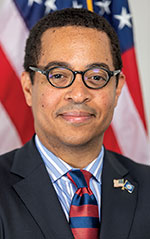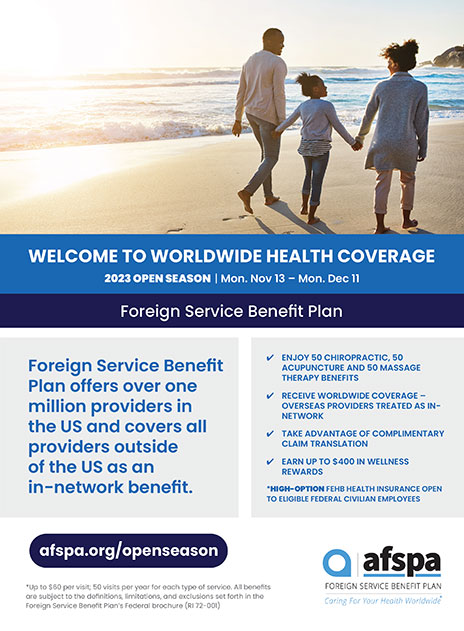Our Foreign Service Adoption Journey
Here is an insightful and heartwarming account of how one couple fulfilled their dream of becoming parents through adoption.
BY CLAYTON BOND

The Bond-Osius family, 2023.
Courtesy of Clayton Bond
We began thinking about becoming adoptive parents many years before we took the plunge. In Washington, D.C., we had attended a “Maybe Baby” class designed for LGBT+ prospective parents that covered a range of topics. We learned about surrogacy and adoption, and settled on the latter.
We also learned that there are open and closed adoptions. Closed adoptions, where the identity of the birth parents is neither known nor sought, are more traditional, but we began to see that an open adoption would be our preference. With an open adoption, the birth parents and adoptive parents are known to each other, and communication between them and the adopted children is encouraged. This is increasingly considered to be the healthiest approach for all parties, and it made sense to us. Our comfort with the idea of an open adoption grew as a result of what we saw and learned from friends who had adopted in that manner.
We didn’t begin taking the formal steps until 2012, during the third and final year of Ted’s assignment in Jakarta. Knowing of our interest in becoming parents, a friend and colleague told us about a little girl who was born with fixable special needs and had been abandoned. She had been looked after in a hospital by friendly nurses for several months but needed a permanent home. We went over to the hospital to visit her. We visited a few more times, brought her gifts, and had an independent doctor examine her to see if there were any other medical concerns we should be aware of, following the informative briefing the hospital’s staff gave us about her special needs. Finding no other issues, Ted and I went about trying to figure out how to become the little girl’s parents.
We already knew what her name would be. We had earlier decided that if we were to have a daughter, she would be Lucy, since each of us had a great aunt named Lucile. Because this little girl was Indonesian, we imagined spelling her name Lusi. We found, to our dismay, though, that we had several fatal strikes against us in trying to adopt Lusi: we were not Indonesian, we were not Muslim, and, of course, we were not a heterosexual couple. Happily, we later learned that another expatriate couple adopted the little girl, whom we believe now has the chance of the full and happy life we had hoped to be able to give her.
The Home Study
In the process of investigating whether we could adopt Lusi, we learned that there was a U.S.-licensed social worker based in Jakarta who could do a home study for us. Even though Lusi was not to be our child, we proceeded with the home study, which we understood we could update once we moved back to Washington, D.C., our next assignment.
The home study, usually the first formal step in the adoption process, was extremely difficult—the emotional and personal baring-all that seemed to be a part of the process was not as onerous as the enormous amount of paperwork.
The emotional and personal baring-all that seemed to be a part of the process was not as onerous as the enormous amount of paperwork.
The social worker required us to provide all kinds of documentation, including evidence of our financial situation, such as pay stubs, mortgage information, bank account statements, retirement accounts, and other investments. She required letters of recommendation from people who knew us and could attest to our suitability to become parents. We needed to provide addresses and police clearances from each of the places where we had lived since we were 18 years old, as well as FBI clearances. We also needed medical clearances, copies of our birth certificates, passports, and state driver’s licenses, as well as our marriage certificate.
And then we chatted several times formally with the social worker, individually and together. We talked about whether and to what extent we would be interested in adopting a child with special needs, and whether we had preferences for the child’s racial or ethnic background or gender. Our social worker had questions about our relationship, about our upbringings, and about how we expected to raise children, including disciplining them.
Since we had gone through the home study process once, it would be easier to update it, as needed, and to later complete a new home study, if nothing else, for the confidence gained from having gone through what at times felt like an ordeal. We knew that it could be done. So, when we moved to Washington, D.C., with one home study completed, we set about finding an adoption agency in the area to work with on updating it to reflect our new circumstances, which included a different home than the one described in our first home study, as well as new work positions for both of us.
We searched for adoption agencies in the D.C. area that were friendly to gay people, and found one in Maryland. They had certain fees to pay and new forms to complete.
Managing the Wait
The agency connected us with one of their social workers, with whom we worked on our home study update. She was insightful about our strengths and weaknesses and offered useful guidance about how to manage the wait for adoption placement. The adoption agency organized structured social evening sessions with other waiting prospective parents, most of whom had been waiting more than a year already. The agency told us that, in some years, there are plenty of babies they are able to place, but that this was a slow period.
Our social worker advised us to go about our lives as normal. She said that we may get a call about a baby, and at that time, we could run to a store, like Target, and get everything we needed. While we had designated a bedroom for our hoped-for-child, we followed our social worker’s advice and did not turn it into a nursery. And we continued to travel, although we started to buy travel insurance, just in case we were to get the call and had to cut our trip short. We visited friends in Oregon and California; we went to Peru, to the United Kingdom. No calls came.
Why wasn’t the process working for us?
About a year after our return to D.C., we attended our adoption agency’s annual picnic. We saw all these happy families, which was great for them and difficult for us. Why wasn’t the process working for us? We ran into our social worker, who told us that before next year’s gathering, we would have a child. We wanted to believe her.
We had only planned to be back in D.C. for two years, and it was approaching a year and a half already. We understood that we needed six months after placement before we could finalize the adoption and get a passport for our child so they could travel with us to our hoped-for next overseas assignment.
One of the things we had been advised to do, to help move things along, was to make sure our network knew we were interested in an adoption placement, in the hope that someone might know someone or something that could help us become parents.
Then, while on a work trip to West Africa, I was chatting with colleagues who were also adoptive parents. They recommended someone who seemed to be successful in matching prospective adoptive parents with children. Ted and I decided to write the matchmaker.
The Dream
Shortly after I returned to the office from my trip, a colleague and friend told me, randomly, as I walked down the hallway near her office, “I had a dream about you.”
“You did? … About something good, I hope?” I answered.
She said she dreamed that I was a father, with a baby. My colleague’s dream took me by surprise. I could not recall whether I had told her already about Ted’s and my hopes to become parents. In any case, Ted and I proceeded with our lives, including plans made six months before to travel to Rio de Janeiro for New Year’s Eve, meeting friends there from Indonesia. We had long before booked our plane tickets and made our hotel reservations.
Our social worker advised us to go about our lives as normal.
We arrived at Dulles International Airport that Saturday morning, full of anticipation. Then I noticed that the airline staff member checking us in appeared flustered. She anxiously searched through our passports, page by page. Uh-oh. We had no visa and realized, painfully, that we would not be able to obtain one on arrival in Rio.
We did some research online, and I called the airline’s main reservation number. We decided to change our ticket to the afternoon flight to Panama, stay there until at least Monday, when we could try and obtain the Brazilian visa, and then proceed to Rio.
En route, we watched movies, had a good meal, and arrived in Panama at about 9 p.m. We planned to let our friends at the U.S. embassy there know we were unexpectedly in town, and try to see if they would be available to get together. We planned to visit the Panama Canal. We would still have a vacation and enjoy ourselves, we resolved.
We started getting ready for bed and decided to quickly check Facebook and email before turning in. I saw a message from one of our friends to call the adoption matchmaker right away. We called, and the matchmaker calmly advised us that she was glad we had done so. A birth mother had just delivered earlier that day, decided to place the healthy baby boy for adoption, and had chosen us to raise the child. There were only 10 minutes until the hospital’s phones would be cut off for the night; the birth mother’s cell phone had run out of juice.
Did we want to proceed? Yes.
Ted and I hadn’t planned to parent a second child, though we hadn’t ruled it out. Our son was about 11 months old when we received word from the adoption agency that his birth mother was again pregnant, this time with a girl, and wanted us to raise that child, as well. The adoption agency told us that they thought the birth mother would give us some time to absorb the news and get back to her. …We did. At last, we had found our Lucy, and our family was complete.
When sharing or linking to FSJ articles online, which we welcome and encourage, please be sure to cite the magazine (The Foreign Service Journal) and the month and year of publication. Please check the permissions page for further details.
Read More...
- “Christmas in July: Holidays as a Foreign Service Child” by Mikkela Thompson, The Foreign Service Journal, June 2003
- “Trailing Tandem” by Clayton Bond, The Foreign Service Journal, May 2011
- “Navigating Life’s Unexpected Realities” by Jen Dinoia, The Foreign Service Journal, May 2011




